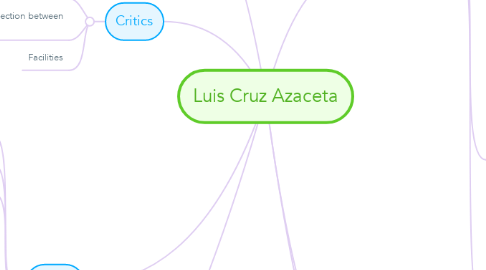
1. Notes
1.1. Lesson or Series Title
1.2. Goals of Each Lesson
1.3. Objectives
1.4. Content
1.5. Method of Instruction
1.6. Method of Evaluation
2. Critics
2.1. Wounds & Screams of human condition
2.2. His art forms an intersection between personal and political
2.3. Facilities
3. Series
3.1. Exile 50
3.2. Swimming to Havana (2009)
3.3. Subway Series (1970)
3.4. Shifting States (2011-2012
3.4.1. Climate change
3.4.2. Economic Disasters
3.4.3. Civil War/Revolution
3.4.4. Movement for Social Justice
3.5. Aids Series (1988)
3.6. Sandy Hook (2012)
3.7. Oklahoma Bombing
3.8. Self Portrait
3.8.1. Transformation
3.9. Post Katrina
4. Artist thoughts
4.1. What I do is create all this kind of abstractions to engage the viewer. Just by the title of. already being a whole association of things that people have seen on television and the station that are happening in that country. So I don't even have to depict people running or people going into exile or people crying or people get dead on the streets or all that kind of stuff. I did that back in the 80s. But the new work is all abstractions and I prefer it that way
4.2. I don't like sentimental paintings. I like them from reality, face on. I like paintings that jump out of the walls. You know, I don't like harmonies. I like cacophones in the the painting. Things that sometimes doesn't fit together, to create a visual dissoncance in the work.
4.3. To me art is a voice and is also weapon, That with it we can change certain aspects of society
4.4. I work in series. The content usually establishes the style or look of the work. The content or themes that I have addressed through the years include urban violence, Latin American dictators, self-portraits as both victim/aggressor, Cuban refugees, balseros, war, terrorism, the Aids epidemic, love, racisim, environmental and man-made disasters-Katrina, the city as place, and lately a series of museum plans
5. Biography
5.1. Born 1942 Cuba
5.1.1. Father Air Force Mechanic
5.1.1.1. Mother
5.1.2. Mother
5.2. Immigrated 1960
5.2.1. Historical Events
5.2.1.1. Batista (1952-1959)
5.2.1.2. Castro (1959) Revolution
5.2.1.3. US Embargo (1960)
5.2.1.4. Cuban Missile Crisis (1961)
5.2.1.5. Cuban Diaspora - 1959-2009 63K Cubans left in small rafts (balseros)
5.2.2. Personal
5.2.2.1. Being conscripted
5.2.2.2. Violence -death-bombing viewed as he worked in pharmacy inEl Vedado
5.2.2.3. Waited in lines 3 days at American Embassy for Visa, screaming crowds
5.2.2.4. Flew out on Cubana de Aviasion with only clothes on back, no money, no language
5.2.2.5. Uncle in Hoboken, NJ claimed him, lived there 2.5 years
5.3. New York City
5.3.1. Started work at a trophy factory in Brooklyn, 3 days after arrival, fired 2.5 years later because of Union Involvement
5.3.1.1. Employ
5.3.2. Moved to Queens (1962)
5.3.3. Self taught/adult classes built his portfolio
5.3.4. 1967 received scholarship School of Visual Arts
5.3.5. 1969 Went to Europe (Goya (black paintings), Max Beckman (German expressinist), Picasso, Stella
5.3.6. 1975 1st Exhibition - Allan Frumpkin Gallery
5.3.7. 1980 - self identified as visual artist
5.4. 1992 New Orleans
5.4.1. 1993 Moved into Bunker could paint large scale paintings
